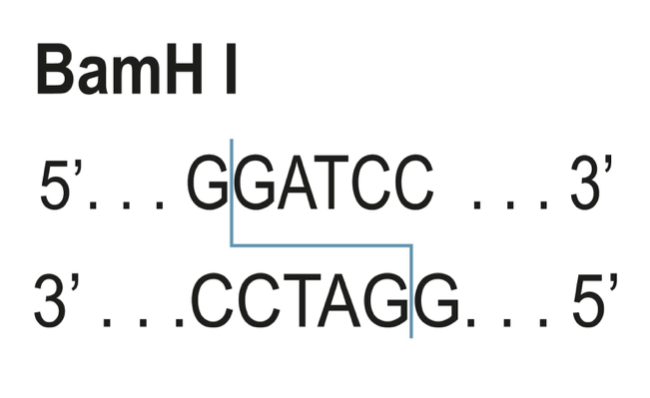
which one of the following is a restriction site for restriction enzyme Bam HI
A) 5'-GAATTC-3'3'-CTTAAG-5'
B) 5'-GGATCC-3'5'-CCATGG-3'
C) 5'-GGATCC-3'3'-CCTAGG-5'
D) 5'-GAATTC-3'5'-GTTAAC-3'
Answer
565.8k+ views
Hint: BamHI is derived from bacillus amyloliquefaciens strain H. Here at a target site cleavage occurs at the short sequence of DNA that is up to 6 base pairs and is a type II restriction endonuclease.
Complete step by step answer:
The restriction enzyme is BamHI. A restriction enzyme is a protein that recognizes a short nucleotide sequence that cuts the DNA at a specific site. The specific site is also known as a restriction site or target sequence.
- BamHI recognizes sequence 5'-G/GATCC-3' and cleaves between the two G's( shown by ' /' in sequence) just after the 5'guanine on each strand.
- This cleave will result in a 4 base pair with a long sticky end.

So, the correct answer is, "5'-GGATCC-3'3'-CCTAGG-5'".
Additional information: BamHI belongs to type II enzymes. Class II enzymes are an important class of restriction enzymes. Type II enzymes and their modification i.e methyl transferase work as a separate protein. Water restriction of DNA and modification of DNA will be carried out by separate enzymes, which make it easy to cleave DNA molecules in the absence of modification.
- The enzymes that belong to this class are site-specific. They usually hydrolyzed phosphodiester bonds in both the strands of DNA which lie near to the recognition sequence.
- Type II enzymes have many practical benefits in molecular biology for cloning, generation of libraries, for DNA sequencing, for detection and overproduction of enzymes, hormones, etc.
- Restriction recognition sites can be unambiguous or ambiguous. Unambiguous means the enzyme BamHI is the only enzyme that recognizes sequence GGATCC and no other enzyme will recognize.
- The site of recognition of one enzyme may have the site of restriction for another enzyme.
Note:
- The restriction enzymes make cuts, one through each of the sugar-phosphate backbones on each strand of DNA without harming the nitrogenous base.
- The nomenclature of every enzyme is done on the basis of bacteria that they were isolated.
Complete step by step answer:
The restriction enzyme is BamHI. A restriction enzyme is a protein that recognizes a short nucleotide sequence that cuts the DNA at a specific site. The specific site is also known as a restriction site or target sequence.
- BamHI recognizes sequence 5'-G/GATCC-3' and cleaves between the two G's( shown by ' /' in sequence) just after the 5'guanine on each strand.
- This cleave will result in a 4 base pair with a long sticky end.

So, the correct answer is, "5'-GGATCC-3'3'-CCTAGG-5'".
Additional information: BamHI belongs to type II enzymes. Class II enzymes are an important class of restriction enzymes. Type II enzymes and their modification i.e methyl transferase work as a separate protein. Water restriction of DNA and modification of DNA will be carried out by separate enzymes, which make it easy to cleave DNA molecules in the absence of modification.
- The enzymes that belong to this class are site-specific. They usually hydrolyzed phosphodiester bonds in both the strands of DNA which lie near to the recognition sequence.
- Type II enzymes have many practical benefits in molecular biology for cloning, generation of libraries, for DNA sequencing, for detection and overproduction of enzymes, hormones, etc.
- Restriction recognition sites can be unambiguous or ambiguous. Unambiguous means the enzyme BamHI is the only enzyme that recognizes sequence GGATCC and no other enzyme will recognize.
- The site of recognition of one enzyme may have the site of restriction for another enzyme.
Note:
- The restriction enzymes make cuts, one through each of the sugar-phosphate backbones on each strand of DNA without harming the nitrogenous base.
- The nomenclature of every enzyme is done on the basis of bacteria that they were isolated.
Recently Updated Pages
Master Class 12 Chemistry: Engaging Questions & Answers for Success

A man running at a speed 5 ms is viewed in the side class 12 physics CBSE

The number of solutions in x in 02pi for which sqrt class 12 maths CBSE

State and explain Hardy Weinbergs Principle class 12 biology CBSE

Write any two methods of preparation of phenol Give class 12 chemistry CBSE

Which of the following statements is wrong a Amnion class 12 biology CBSE

Trending doubts
What are the major means of transport Explain each class 12 social science CBSE

Which are the Top 10 Largest Countries of the World?

Draw a labelled sketch of the human eye class 12 physics CBSE

Explain sex determination in humans with line diag class 12 biology CBSE

Explain sex determination in humans with the help of class 12 biology CBSE

Differentiate between homogeneous and heterogeneous class 12 chemistry CBSE




